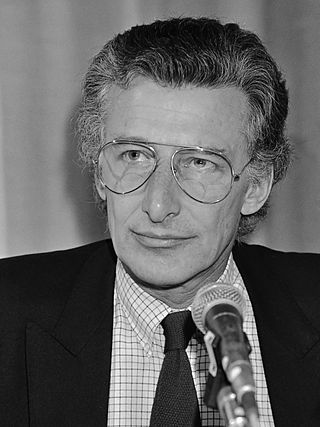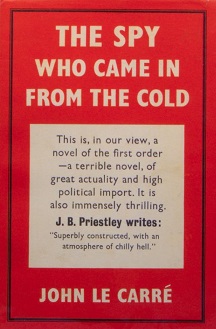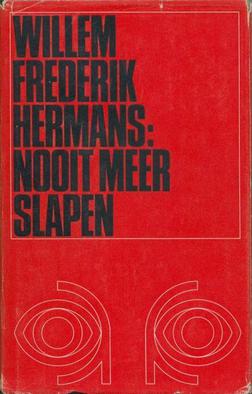
Harry Kurt Victor Mulisch was a Dutch writer. He wrote more than 80 novels, plays, essays, poems, and philosophical reflections. Mulisch's works have been translated into 38 languages so far.

The Spy Who Came in from the Cold is a 1963 Cold War spy novel by the British author John le Carré. It depicts Alec Leamas, a British agent, being sent to East Germany as a faux defector to sow disinformation about a powerful East German intelligence officer. It serves as a sequel to le Carré's previous novels Call for the Dead and A Murder of Quality, which also featured the fictitious British intelligence organization, "The Circus", and its agents George Smiley and Peter Guillam.

Willem Frederik Hermans was a Dutch author of poetry, novels, short stories, plays, as well as book-length studies, essays, and literary criticism. His most famous works are The House of Refuge, The Darkroom of Damocles, and Beyond Sleep.
Dutch language literature comprises all writings of literary merit written through the ages in the Dutch language, a language which currently has around 23 million native speakers. Dutch-language literature is the product of the Netherlands, Belgium, Suriname, the Netherlands Antilles and of formerly Dutch-speaking regions, such as French Flanders, South Africa, and Indonesia. The Dutch East Indies, as Indonesia was called under Dutch colonization, spawned a separate subsection in Dutch-language literature. Conversely, Dutch-language literature sometimes was and is produced by people originally from abroad who came to live in Dutch-speaking regions, such as Anne Frank and Kader Abdolah. In its earliest stages, Dutch-language literature is defined as those pieces of literary merit written in one of the Dutch dialects of the Low Countries. Before the 17th century, there was no unified standard language; the dialects that are considered Dutch evolved from Old Frankish. A separate Afrikaans literature started to emerge during the 19th century, and it shares the same literary roots as contemporary Dutch, as Afrikaans evolved from 17th-century Dutch. The term Dutch literature may either indicate in a narrow sense literature from the Netherlands, or alternatively Dutch-language literature.

Willem Johannes Theodorus Kloos was a nineteenth-century Dutch poet and literary critic. He was one of the prominent figures of the Movement of Eighty and became editor in chief of De Nieuwe Gids after the editorial fracture in 1893. He was nominated for the Nobel Prize in Literature five times.

The Tachtigers ("Eightiers"), otherwise known as the Movement of Eighty, were a radical and influential group of Dutch writers who developed a new approach in 19th-century Dutch literature. They interacted and worked together in Amsterdam from the 1880s. Many of them are still widely read today.

Frederik Willem van Eeden was a late 19th-century and early 20th-century Dutch writer and psychiatrist. He was a leading member of the Tachtigers and the Significs Group, and had top billing among the editors of De Nieuwe Gids during its celebrated first few years of publication, starting in 1885.
Flemish literature is literature from Flanders, historically a region comprising parts of present-day Belgium, France and the Netherlands. Until the early 19th century, this literature was regarded as an integral part of Dutch literature. After Belgium became independent from the Netherlands in 1830, the term Flemish literature acquired a narrower meaning and refers to the Dutch-language literature produced in Belgium. It remains a part of Dutch-language literature.

Renate Ida Rubinstein was a German-Dutch writer, journalist and columnist.
Like Two Drops of Water is a 1963 Dutch drama film directed by Fons Rademakers. It is an adaptation of the 1958 novel The Darkroom of Damocles by Willem Frederik Hermans. It was entered into the 1963 Cannes Film Festival and was selected as the Dutch entry for the Best Foreign Language Film at the 36th Academy Awards, but was not accepted as a nominee.

Herman Rudolf "Rudy" Kousbroek was a Dutch poet, translator, writer and first of all essayist. He was a prominent figure in Dutch cultural life between 1950 and 2010 and one of the most outspoken atheists in the Netherlands. In 1975 he was awarded the P.C. Hooft Prize for his essays.
NRC's Best Dutch novels is a list of the most popular Dutch-language novels as of 2007.

Herman van der Mijn, or Heroman van der Myn, was an 18th-century painter from the Northern Netherlands.

Beyond Sleep is a novel by the Dutch writer Willem Frederik Hermans, published in February 1966. The protagonist, Dutch geologist Alfred Issendorf, has a geology dissertation in preparation, and embarks on an expedition to Finnmark, northern Norway, to verify his dissertation director's theory that craters in the local landscape were formed by meteor impacts rather than by Ice Age glaciers. Initially he is accompanied by a group of three Norwegian students of geology, but soon after he is isolated from his companions wandering on his own in a land where the sun never sets.

The Royal Theater Carré is a Neo-Renaissance theatre in Amsterdam, located near the river Amstel. When the theatre was founded in 1887, it was originally meant as a permanent circus building. Currently, it is mainly used for musicals, cabaret performances and pop concerts. Carré is located next to the Amstel, close to Waterlooplein. Its address is Amstel 115 and has approximately 1,700 seats.
The Collectieve Propaganda van het Nederlandse Boek is a Dutch organization that includes representatives of bookstores and publishers, whose goal is to promote Dutch literature.
David Colmer is an Australian writer and translator, mainly of Dutch-language literature. He translates novels, poetry and children's literature and is the current English translator of Gerbrand Bakker, Dimitri Verhulst, Annie M.G. Schmidt, and Nachoem M. Wijnberg. Colmer's poetry translations include selections of the work of Hugo Claus, Anna Enquist, Cees Nooteboom, Ramsey Nasr and Paul van Ostaijen.
Nico Jesse was a Dutch humanist photographer and photojournalist and later a commercial and advertising photographer. Originally a physician, he combined his work as a doctor with his passion for photography until, in 1955, he gave up his medical practice to devote himself exclusively to photography, producing imagery for several companies’ annual reports and business documents. He also made a large number of books about cities and countries in Europe and mounted exhibitions of the images, the most famous being Women of Paris (1954), and contributed to a mass observation project of Nazi-occupied Utrecht. In 1962 Nico Jesse took up his original profession again and at his death in 1976, left a large photographic oeuvre, in which people and their everyday activities are the focus.

Preanger Regencies Residency, sometimes referred to as Preanger Residency and renamed Priangan Residency after 1931, was an administrative division (residency) of the Dutch East Indies located in Parahyangan, West Java which existed from 1817 to 1925. Its capital was in Cianjur until 1856 and thereafter in Bandung. The residency contained the municipality of Bandung and the regencies of Bandoeng, Soemedang, Tasikmalaja, Tjiamis and Garoet.

Willem Cornelis Bauer also known as Wilhelm Bauer was a Dutch architect and painter.













